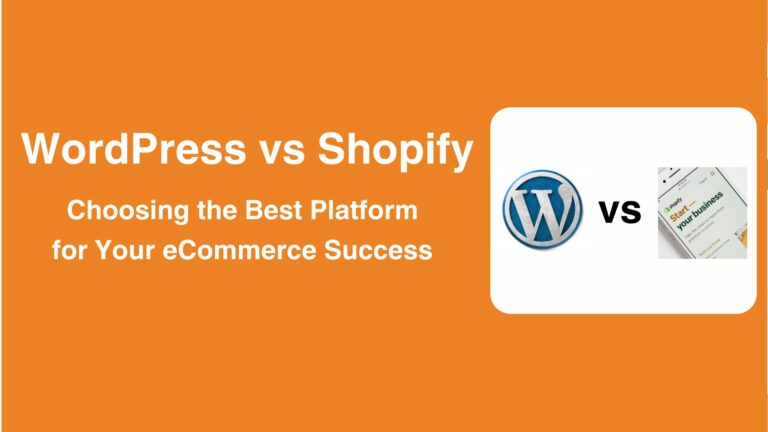Choosing the right platform for building an ecommerce store is a critical decision that can greatly impact the success of your online business.
WordPress and Shopify are renowned for website building. Deciding which performs better for your e-commerce store requires evaluating various indicators. Can a clear winner emerge in the WordPress vs. Shopify battle after this comparison?
Users need to weigh their personal needs against the offerings of each platform. This informs a sound choice towards creating a robust online presence for any ecommerce business.
Key Takeaways
- WordPress and Shopify cater to different user needs and offer unique tools for building online stores.
- Consideration of ease of use, flexibility, and growth potential is crucial when choosing an ecommerce platform.
- Both platforms provide a foundation for establishing a successful ecommerce operation, but vary in user technicality and design approach.

WordPress vs Shopify
When choosing an ecommerce platform, one must consider ease of use, customizability, and control.
WordPress with WooCommerce
WordPress was founded in 2003 by Matt Mullenweg and Mike Little as a blogging platform. It quickly evolved into a robust content management system (CMS). In 2004, themes and plugins were introduced, enhancing customization. It offers over 60,000 plugins. These plugins cover a wide range of functionalities.
WordPress, coupled with the WooCommerce plugin, offers a robust solution for building an online store. This powerful duo is highly customizable, allows extensive control over hosting, and maintains an open-source status which is perfect for achieving multiple functions.

source: SEMRush
Pros of WordPress with WooCommerce :
- Open-source plugin for WordPress, offering extensive customization options.
- Access to thousands of plugins for site customization.
- Cost control by choosing hosting providers and plugins.
- Enhanced SEO control and multilingual capabilities.
- Multi-site feature for managing multiple sites under one account.
Cons of WordPress with WooCommerce :
- Requires coding knowledge or paid builders like Elementor.
- Responsibility for hosting, domain registration, security, and backups.

Shopify stands out as a user-friendly platform that streamlines the setup process of an online shop with its dedicated support and drag-and-drop editor. No coding knowledge is necessary to launch a visually appealing and mobile-responsive store. Through Shopify, purchasing and managing a domain becomes straightforward. However, as a fully hosted solution, it imposes limitations on server control and site customization, which might not suit those who wish to tinker with server settings or require unique customizations.
Shopify Pros:
- Beginner-friendly interface with drag-and-drop editor for easy store setup.
- Fully hosted solution, eliminating the need to find a hosting service.
- Dedicated support and streamlined domain purchasing.
Shopify Cons:
- Limited server control and customization compared to WordPress.
- Inability to access server logs for debugging.
- May not suit users who require extensive customization or server control.
Setting Up Your Online Store
When building an ecommerce store, one must carefully consider the platform and the technical foundations they set.
Choosing the Right Hosting Provider
Hosting is essential because it affects the speed, security, and uptime of the online shop. For those leaning towards WordPress.org, selecting a reliable hosting provider is imperative. They’ll need to research and choose a service that specializes in WordPress, ensuring optimized performance for this content management system.
Shopify, on the other hand, is a hosted platform, meaning the hosting is inbuilt. This can simplify the setup process, as builders need not seek out hosting services separately. This all-encompassing approach may include Shopify Payments, streamlining the management of transactions.

Selecting Your Domain Name
A domain name is the digital address where customers can find one’s online store. It plays a significant role in branding and making the store memorable. Whether one chooses Shopify or WordPress, the domain should be:
- Concise: Easy to type and remember.
- Relevant: Reflective of what the ecommerce platform sells or offers.
For Shopify users, the platform offers domain registration services, while WordPress users will need to secure a domain through a separate registrar. The plan WordPress offers allow users to use free domain name for a year. Regardless of the path one takes, the chosen domain should align with the brand and be easy for customers to associate with the online shop.
Payment and Transaction Fee
When building your own ecommerce store, effectively managing operations is crucial for success. These operations primarily involve handling orders, managing inventory, and navigating payment gateways with associated fees. Choosing the right platform, whether it be Shopify with its built-in solutions or WordPress with its flexible plugins, can significantly impact these aspects.
Understanding Payment Gateways and Fees
Navigating payment gateways and understanding associated fees are essential for managing the financial side of ecommerce. Both Shopify and WordPress integrate with major payment gateways like PayPal and Stripe, making it easier to accept payments from customers globally.
Shopify charges a transaction fee on top of standard payment gateway fees. For example, the Advanced plan has provisions for localized global selling, and additional markets can be added at a cost:$59 USD/mo each
WordPress offers different plans with varying transaction fees. The Starter plan includes an 8% transaction fee, while the Entrepreneur plan reduces the fee to 2%, excluding the standard processing fees charged by the payment gateway itself. Choosing the appropriate WordPress plan, such as the Creator plan, which offers 0% transaction fees for standard WooCommerce payment features, can be beneficial for managing costs.
| Features | WooCommerce | Shopify Basic | Shopify Regular | Shopify Advanced |
|---|---|---|---|---|
| Pricing | Free | $29/month | $79/month | $299/month |
| Abandoned cart mail | No | Yes | Yes | Yes |
| Transaction fees | No | 2% without Shopify Payments | 1% without Shopify Payments | 0.5% without Shopify Payments |
| Brick-and-mortar PoS | No | Yes (at +$89 per month) | Yes (at +$89 per month) | Yes (at +$89 per month) |
| Built-in payment | Stripe, PayPal | Shopify Payments | Shopify Payments | Shopify Payments |
| Real-time shipping rates | No | Yes | Yes | Yes |
| Open-source | Yes | No | No | No |
| Hosted | No | Yes | Yes | Yes |
| SSL certificate | No | Yes | Yes | Yes |
| Up & cross selling | Yes | No | No | No |
| Free themes | Yes | Yes | Yes | Yes |
| Supplier integrations | Yes, WordPress plugins | Yes, Shopify App Store | Yes, Shopify App Store | Yes, Shopify App Store |
| 24/7 customer support | No | Yes | Yes | Yes |
| Free Domain | No | Yes, (Shopify and Shopify Advanced) | Yes, (Shopify and Shopify Advanced) | Yes, (Shopify and Shopify Advanced) |
Every transaction will have a transaction fee, and it’s vital for store owners to understand these costs to price their products appropriately and maintain profitability.
Both platforms provide the tools necessary for managing ecommerce operations effectively, with each offering different structures and fees that cater to the varying needs of online merchants.
Order Processing and Inventory
Shopify streamlines order processing and inventory management through its integrated system. It allows for real-time tracking of stock levels, automated order updates, and fulfillment processes. Businesses can scale operations by selling in multiple markets with the Advanced plan.
In contrast, WordPress users typically rely on WooCommerce, a highly customizable plugin that facilitates inventory management and order processing. Users can set up various payment options and track orders directly from their dashboard.
Both platforms allow entrepreneurs to keep close tabs on their products and orders, ensuring they can respond promptly to customer demands and maintain an efficient replenishment system.

Customizing Your Ecommerce Experience
When building an ecommerce store, customization is paramount for branding and functionality. One’s choice in themes, templates, plugins, and apps defines how unique and user-friendly their online store will be. This section discusses how to tailor the shopping experience using these tools.
Themes and Templates
Themes and templates are the foundation of an ecommerce site’s appearance. Shopify offers a range of professionally designed themes that are both eye-catching and responsive. These themes ensure that an ecommerce site is accessible on all devices, from desktops to mobile phones. For more specific needs, a merchant can choose from thousands of themes and templates specifically crafted for various industries. See a comparison of themes at Forbes Advisor.
In contrast, WordPress, when paired with the WooCommerce plugin, allows for even greater customization. Users can choose from a multitude of free and premium themes that cater to virtually any aesthetic. Additionally, WordPress themes are highly customizable, often offering their own set of customization tools and options. Users may need some web development knowledge to fully exploit these options, but the flexibility is unparalleled. Get a glimpse of WordPress templates at NerdWallet.
Integrating Plugins and Apps
Plugins and apps play a crucial role in adding bespoke ecommerce features to one’s store. Shopify’s App Store contains a wealth of apps that can extend the functionality of an ecommerce store, from SEO tools to customer loyalty programs. The seamless integration Shopify provides ensures that business owners can implement new features without requiring extensive technical skills. Learn about Shopify’s built-in tools at Shopify’s Comparison.
For those using WordPress with WooCommerce, there is a similar level of plugin integration available. The WordPress plugin repository provides users with a vast array of plugins for everything from payment gateways to product display enhancements. One can greatly enhance their store’s capabilities, though they must ensure that plugins are kept up to date and are compatible with each other to prevent potential issues. Understand WordPress’s plugin integration at Semrush’s blog post.

Growing Your Ecommerce Business
When venturing into an ecommerce business, the growth phase is critical. It involves not only setting the right foundation but also leveraging effective marketing and optimization strategies to reach and convert a wider audience.
Marketing and SEO Strategies
Marketing is the lifeblood of ecommerce growth. A robust marketing plan includes various channels, such as email campaigns and content marketing, crafted to meet your audience’s needs. For example, consistent blog posts related to your products can drive organic traffic and engage customers. When it comes to search engine optimization or SEO, using platforms like WordPress can give your store a significant edge due to its inherent strengths in content creation and optimization.
To enhance your store’s visibility in search engines, ensure each product description is keyword-rich yet readable. You can also benefit from WordPress’s vast array of SEO plugins that simplify metadata management and improve page load times, which is vital since speed is a significant factor in user experience and SEO rankings.
Expanding with Multi-Channel Sales
Expanding your ecommerce store to multi-channel sales opens up new opportunities. Listing your products on marketplaces like Amazon and eBay can significantly increase visibility and sales volume. These channels not only put your products in front of a broader audience but also allow you to tap into their vast logistical and customer service frameworks.
Using WordPress, you can integrate various sales channels with your store, ensuring that inventory and sales data remain synchronized across all platforms. This coordinated approach to online sales means you can manage your products effectively without duplicating effort, whether they’re sold on your website or a global marketplace.
By focusing on these powerful tactics, you can set your ecommerce business on a path of sustainable growth.

